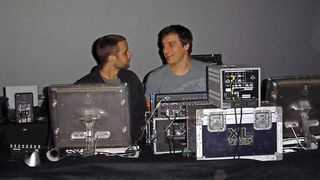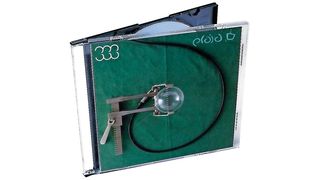When Ed Handley and Andy Turner left the legendary Electronic outfit The Black Dog in 1995, it wasn't a case of them shuffling down the job centre, cap in hand. They were snapped up by Icelandic Pop sensation Bjork to join her crew on tour, providing keyboard backing and general techy wizardry.
Bounding across the Far East and beyond gave the pair all the time in the world to dream up post-Dog musical directions to embark on when they settled back down on their native soil. "We were really motivated to write because of the break we'd had on the road," says Ed. "We hadn't written for about a year and a half, so we were very keen to get back into the studio when we finished the Bjork tour.
"We'd also got a bit of new gear with the funds that we'd earned. We rented a big flat to impress some girls and started messing around with loads of cool new gear the Bjork tech crew had put us on to."
"We rented a big flat to impress some girls and started messing around with loads of cool new gear the Bjork tech crew had put us on to."
New gear, new direction, old name. Plaid had been a title the boys had recorded under before, but it felt right to resurrect it. "We'd done an album [Mbuki Mvuki] under the Plaid name in 1991," says Andy. "It was self-released when we were still in the other band. Not For Threes was the first Plaid album on Warp, and it felt very much like a new project."
This seminal album is far more sample-heavy than The Black Dog-era material, and is also notable for its use of vocalists. "We ended up working with three different singers," says Andy. "Again, this was a departure for us because this was the first time we'd tried to incorporate voice into what we do."
Besides Bjork (nothing like turning in a favour, eh lads?) you get Mara Carlyle and Massive Attack collaborator Nicolette on the mic. Not that there really are any lead vocals. The human voice, like any hardware at their disposal, was treated like a sample source and tweaked in innovative new ways.
"We wanted to try everything and experiment with every sound on this album," says Ed. "Voice was no different."
Andy Turner and Ed Handley take us through Not For Threes track by track.
Abla Eedio
Ed Handley: "The main studio at the time was a room in our house just off Finchley Road in London, which we were renting. The neighbour wasn't happy. That's the reason we had to move in the end, which was fair enough. We didn't have massive speakers, they were fairly modest, but there was no soundproofing or anything. We got the odd bad stare in the morning [laughs]."
Andy Turner: "We rented this little cottage in Devon after our neighbour in London really complained about the noise. We went down there for a week to work on the mixes so we could listen to stuff loud."

Kortisin
Ed: "This was one of the first tracks we did with the guitarist Benet Walsh, who we still work with today. He's pretty much had some sort of material on every album we've written. He can play a lot of instruments and shares a very similar sort of sense of harmony as we do, so we work quite well together.
"This track was the result of us just jamming around in the studio a bit. The result was slightly Baroque, hence the title."
Headspin
Ed: "We're both ex-breakdancers, so this was a sort of homage to [old school b-boys] the Rock Steady Crew. I think there is even a sample where one of them is describing a headspin in his dreams that goes on forever. We just liked the sound of that. That was our breakin' track.
"What was my favourite move? Well, I used to be a body-popper… Actually I wasn't really anything. I just used to clean the lino. I was the tea boy [laughs]. Andy was quite a power mover, but not these days [laughs]."
Myopia
Ed: "This track features the vocalist Mara Carlyle, who has worked a lot over the years and is still releasing her own material today. She's also guitarist Benet Walsh's sister. I think we met her via Rob Mitchell from Warp, who was one of the founders of the label, who sadly died a few years ago.
"There's a bit of steel drumming on here, too. We had a little toy steel drum kicking around. I think it was from a trip Andy took to Trinidad. We both have a bit of an affinity for that sound. I think I'm attracted to the high harmonics."
Lat
Ed: "This one is about 46 seconds long. I think it was just us trying to join some of the pieces together with little fills. This was just one of them. From what I remember it's a little bit of a drum workout.
"There are some Kung Fu samples in there from old VHS tapes. We did all the things you're supposed to do, which is to watch old Kung Fu films. I think using punch and kick sound effects to back up your drum hits can be quite effective."
Extork
Ed: "This features the [Massive Attack] singer Nicolette. We met her through Leila, who is on a later track off this album, Getting. This is quite an aggro track. I remember at the time it was a bit of a 'fight the power' track.
"The drum break on here has a lot of effects on it. We don't normally do that 'saturated' sound, so this was one of the first times we'd released a really distorted piece of music."
Prague Radio
Ed: "There are some strings sounds in there that were sampled from one of the toilets on the Bjork tour bus. We noticed one night as we were driving along that it was producing a deep, windy whistling.
"Wind must have been coming back up through the bend to produce this nice string, paddy, sound. So we sampled it. It happened as we were driving through Czechoslovakia, so we gave it that title.
"We liked recording natural sounds. We'd be quite up for processing, so you can never normally tell what they really are."
Fer
Ed: "This is the one with bird samples in. I don't know if they were ours. They may have been from a sample CD of Amazonian birds. When you listen to them they don't sound like European birds to my ears."
Andy: "No, they are definitely Amazonian [laughs]. The reason we used a lot of samples is because we were able to. It was the first time we got the Yamaha CBX-D5 digital recording processor. It was literally the ability to sample found sounds that made us do it."
Ed: "It also has a pitch-shifting, portamento-type, bendy thing going on, hasn't it? We were very much into Orbital."
Ladyburst
Andy: "I'm credited as doing some vocals on here. I'm in the back, really quiet. It was Mara Carlyle who was singing the most prominently, fortunately, on here though [laughs]."
Ed: "I remember being inspired by all the early rave people like ShutUp & Dance around the time, as well. They were a big influence on us with what they were doing with breaks. Same with a lot of the jungle people."
"I remember being inspired by all the early rave people like ShutUp & Dance around the time, as well. They were a big influence on us with what they were doing with breaks." Ed Handley
Rakimou
Andy: "This is an old traditional Greek song, so it's kind of a cover, I suppose. It's one where they can't really trace the original author, as it's a folk song.
"Benet is back on here playing some plucked and bowed violin on this one. We sampled and cut up his work on this particular track. We took each individual pluck and sequenced those in, but the bowed violin was overlaid as played."
Ol
Andy: "This is the most 4/4 track of the album. It's the most traditional techno track. It was a very positive moment for us when we were writing this album. We were expressing a lot of different musical loves. We never avoided techno - we've just never been able to write it particularly well."
Seph
Andy: "This was written when we hired the cottage in Devon to get some songs finished. We'd been travelling a lot on the Bjork tour and weren't really back in the UK for long periods. We came back from one long stretch and set up there. On the road we'd been getting ideas together, but nothing was solid. This was the first moment we had some serious time to nail some of the mixes."
Lilith
Andy: "This has Bjork on. We were hanging out a lot with her at that point and we were living quite close to her in London so managed to rope her in to do some vocals on this one.
"Was she famous at the time? Yeah, it was post-Post, the album that seemed to bring her to public prominence in the UK. She's an amazing person to work with. She's very creative and doesn't need much direction I'd say - at least working with us. She's full of great ideas."
Ed: "I think the track title comes from the school of thought that the Earth had a second moon and they gave it the name Lilith, as well."
Forever
Andy: "This track was inspired by the band Return to Forever. We lifted the kind of jazzy time signature from them and wrote something around it. "The house we wrote a lot of the album in was in London, and it used to be owned by the guy behind the Airfix model company. It was quite a grand flat. We were dating girls across the road, so we showed off and rented this flat, even though we could have both put deposits down on a proper house and had a cushy life [laughs], but we totally blew it to impress ladies."
Ed: "It did have a wood panel living room."
Getting
Andy: "This features Leila playing piano. I don't think it was a real piano; it's a MIDI one. But, yeah, the riff is by Leila. Her background was quite jazz-based and she was a really good keyboard player. She'd also had tracks out on Rephlex. She was the impetus to this track, then we wrote a beat that has that kind of '90s hip-hop swing to it. We were still using the Akai S950, which was quite hip-hop."
"Our expectations were quite low with this album. We were happy with the music, but we were unsure about our future as a band." Andy Turner
Milh
Andy: "This has quite an introspective sound. It was always going to be the last track. It's last on the album as it feels like a closer.
"I like the stuttery beat that kicks in. I think it was us getting to know the E-mu Emulator EIV, which we managed to get at the time, and figuring out all the looping and editing things you could do with that. A lot of the programming style on this comes from us getting acquainted with that new technology.
"Our expectations were quite low with this album. We were happy with the music, but we were unsure about our future as a band as we'd lost the small fame we'd gained with the Black Dog name. We didn't know if people would bother to check us under a new banner."
Ed: "It was a weird mix of optimism and fatalism, really."
Plaid's tenth album, Reachy Prints, is available now on Warp Records.


